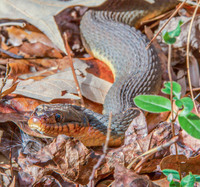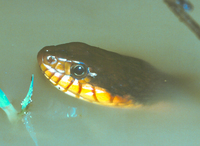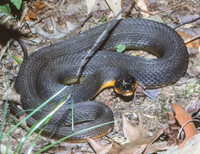Taxonomy
Class: ReptiliaOrder: SerpentesFamily: ColubridaeSubfamily: NatricinaeOther Common Name(s): Red-bellied Water Snake- Plain-bellied Watersnake
Taxonomic Comments: Nerodia , as currently considered, consists of ten species of semiaquatic, moderately large natricid snakes native to eastern and central North America, ranging from southern Canada down to the Gulf Coast of Mexico. For some time, North American members of this genus were considered part of the genus Natrix ; Rossman and Eberle (1977) restricted Natrix to European taxa and resurrected Nerodia for North American species.Species Comments: Nerodia erythrogaster , the Plain-bellied Watersnake, is one of four Nerodia in North Carolina. This species is distributed across the southeastern United States, from southern Maryland south to the panhandle of Florida, and west to central Texas and northern Mexico. Disjunct populations existed in the Midwest as far north as Michigan. In North Carolina, the species ranges down the Coastal Plain to the eastern Piedmont, and is absent in the western Piedmont and Mountains.N. e. erythrogaster ("Red-bellied Watersnake"). Makowsky et al. (2010) found little support for the subspecies, and instead all populations represented a single, widespread species with variable phenotypes. Thus, no subspecies are currently recognized.Nerodia is derived from the Greek neros , "flowing" or "liquid", and dia , "through". The specific epithet erythrogaster is derived from the Greek erythros , "red", and gaster , "belly".
Identification
Description: Plain-bellied Watersnakes are large, stout-bodied snakes. Adult dorsal color is variable, but typically uniformly gray, brown, or reddish-brown. The venter is red or orange, with lighter coloration on the chin and labial scales. Dark bars are often apparent between supralabials.Morphological Features: Plain-bellied Watersnakes typically have 23 strongly keeled midbody scale rows. Ventral counts range from 132-161 (141-153 in NC specimens; Palmer and Braswell, 1995), with 46-90 (62-85) subcaudals and a divided anal plate. Head scale counts are typically as follows: 8 supralabials, 10 infralabials, 1 loreal, 1 preocular, 3 postoculars, 2 nasals, and 1+3 temporals. Palmer and Braswell (1995) noted variation in scalation across multiple specimens in NC. Nerodia often will be found missing portions of their tail. Females reach larger sizes than males; males have longer tails, more subcaudals and fewer ventrals. Juvenile males have more crossbands and blotches on the body than juvenile females.Technical Reference: Palmer and Braswell (1995); Ernst and Ernst (2003); Gibbons and Dorcas (2004)Field Guide Descriptions: Palmer and Braswell (1995); Ernst and Ernst (2003); Gibbons and Dorcas (2004); Beane et al. (2010).Online Photos: Google iNaturalist GBIF Observation Methods: Plain-bellied Watersnakes may be found throughout the day. They are often near water, but may be found crossing open land or under cover objects. They can be commonly encountered on roads, and are often killed as a result.
Distribution in North Carolina
County Map: Clicking on a county returns the records for the species in that county.
Key Habitat Requirements
Habitat: Plain-Bellied Watersnakes inhabit a wide variety of permanent or semi-permanent waters in the Coastal Plain,including ponds, lakes, swamps, marshes, and slow flowing streams (Palmer and Braswell, 1996; Beane et al., 2010). It is widespread and common in the Coastal Plain but also occurs in the adjoining portions of the Piedmont, especially in the Triassic Basins, where there are extensive sloughs and other sluggish water habitats similar to those found in the Coastal Plain.Biotic Relationships: Plain-bellied Watersnakes predate a broad array of aquatic prey and seem to consume a larger proportion of amphibians—especially frogs— than other Nerodia (Gibbons and Dorcas, 2004). Fish consumed include suckers (Catostomidae), sunfish and bass (Centarchidae), minnows and shiners (Cyprinidae), pickerel (Esocidae), topminnows (Fundulidae), catfish (Ictaluridae), perch (Percidae) and mosquitofish (Poeciliidae). Amphibians consumed include larval and aquatic salamanders (including ambystomatids, amphiumas, and sirens) and adult frogs and their tadpoles (including toads, tree frogs, and true frogs). Aquatic insects and crayfish have also been reported (Palmer and Braswell, 1995; Ernst and Ernst, 2003; Gibbons and Dorcas, 2004).Chelydra serpentina ), and juveniles are known prey of largemouth bass (Palmer and Braswell, 1995; Gibbons and Dorcas, 2004).
Life History and Autecology
Breeding and Courtship: Plain-Bellied Watersnakes reach sexual maturity at body lengths of approximately 74 cm. Mating occurs in the spring and early summer (April to June).Reproductive Mode: Plain-Bellied Watersnakes are viviparous; young are typically born in late summer (August to October), though reports as early as April exist. Litters average 17–20 neonates.Aquatic Life History: Plain-bellied Watersnakes are semiaquatic and while some sources suggest they prefer slow-moving waters, these snakes can be found in and around most permanent or semipermanent bodies of water within their range.Terrestrial Life History: Some sources (Ernst and Ernst, 2003) consider Plain-bellied Watersnakes to be primarily nocturnal, but like Palmer and Braswell (1995) we have frequently encountered them during the day (especially early and midmornings) crossing roads; they’ve also been found basking in sunny areas near water, or active in dried canals in forested areas, and will frequently travel great distances from water. Hibernacula include animal burrows, rock crevices, rotting logs and stumps, or burrows along banks. They have been recorded in North Carolina from February–November; most records are from May to July. 2 ; Minimum Convex Polygons; Camper, 2009).
General Ecology
Adverse Environmental Impacts
Status in North Carolina
NHP State Rank: S5Global Rank: G5
Photo Gallery for Nerodia erythrogaster - Plain-bellied Watersnake 19 photos are shown. Recorded by: Paul Hart Recorded by: Mark Shields Recorded by: K. Sanford Recorded by: Erich Hofmann and Kayla Weinfurther Recorded by: Erich Hofmann and Kayla Weinfurther Recorded by: K. Sanford Recorded by: Erich Hofmann and Kayla Weinfurther Recorded by: M Perkins Recorded by: Erich Hofmann and Kayla Weinfurther Recorded by: Erich Hofmann and Kayla Weinfurther Recorded by: Erich Hofmann and Kayla Weinfurther Recorded by: Erich Hofmann and Kayla Weinfurther Recorded by: Erich Hofmann Recorded by: j.wyche Recorded by: Erich Hofmann Recorded by: Erich Hofmann Recorded by: Steve Hall, Ed Corey, and Dave Lenat Recorded by: Steve Hall Recorded by: Steve Hall

 »
» 



 »
» 

